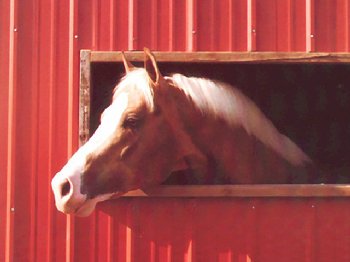

The striking, golden coat color known as palomino occurs in very early artifacts of Europe and Asia and is also prominent in Japanese and Chinese art prior to the Ch'in period (221-206BC). The color is also found in many horse and pony breeds. For that reason, the palomino is a "color type" and not really a "breed". It has been suggested that the name palomino is derived from that of a Spanish Don, Juan de Palomino, who received such a horse from Hernan Cortes. Another explanation is that it takes the name of a golden Spanish grape.
In America, where the palomino is bred extensively, it has acquired virtual breed status through the efforts of the Palomino Horse Association Inc., a body formed in 1936 "for the perpetuation and improvement of the Palomino horse through the recording of blood lines and issuing of certificates of registration to qualifying horses." The Association defines the desirable characteristics of the palomino in its official standard, allowing the height to be 14.1 to 16hh.
The Spaniards introduced the palomino color to America in the horses they brought with them, and it is now found in many American breeds and types. It occurs frequently in the Quarter Horse and the Saddlebred but it does not appear in purebred Arabians or Thoroughbreds.
Palominos are much in demand in Western riding activities and not only as showy "parade" horses. They can be seen at horse shows, they are used for pleasure and trail rides and they are attractive and exciting to watch in parades.
The conformation is that of the predominant cross, and may incline toward the stock horse type or the finer parade type. The head, whether the horse inclines toward the Quarter Horse or to the Arabian or Thoroughbred, must be one of quality. No horse is considered for registration that "shows coarse, draft horse, Shetland or Paint breeding." Eyes should be dark or hazel and both of the same color. White markings on the face are limited to a blaze, snip or star. The tail must be full and white and there should be no suspicion of a dorsal stripe on the back, as found in the dun coloration. Zebra marks on the legs, the unmistakable sign of primitive origin, are similarly unacceptable. White markings often occur on the legs, but they must not extend above the knees or hocks. The horse should stand on well-set legs. Skin pigmentation is either dark or of a golden color. The body color is defined as being the gold of a newly minted coin and may be no more than three shades lighter or darker. Mane and tail are shining white and must not contain more than 15% dark hair. Smudge or smut marks on the coat are not desirable.
Reference: The Ultimate Horse Book; Elwyn Hartley Edwards; 1991

Palomino Links
Palomino Horse Breeders of America
Reference photo courtesy of Black Horse Trading Co.
Background photo courtesy of Whispers of the Vagabond
